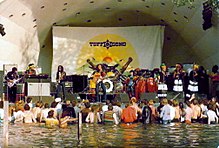


The Crystal Palace Park Concert Platform, formerly the Crystal Palace Bowl, is an outdoor stage and performance venue in Crystal Palace Park in the London Borough of Bromley.
The platform and stage are positioned within a small lake overlooking a large bowl in the landscape that is capable of holding 8,000 people. The stage can accommodate a 100 piece orchestra. The platform has what has been described as the world's first computer controlled outdoor active acoustic system, with a total of 46 speakers. A pair of columns either side of the platform contain more speakers and an amplification system.
History
The Crystal Palace Bowl was constructed in 1961. It originally hosted classical concerts, before moving to popular music through the 1970s and 1980s.
Pink Floyd performed at the Bowl on 15 May 1971 to a crowd of 15,000, though their performance was marred by heavy rain. Yes performed at the venue on 31 July. At one event in 1972, The Who drummer Keith Moon acted as compere; after arriving via helicopter and reaching the stage by hovercraft, he proceeded to take a rowing boat on the lake and, while dressed as a pirate, served tea and cake to people in the crowd closest to the waters edge. Audience members, again went into the lake in 1974 when inflatable dinosaurs meant to act out, on the water, the climactic battle in Rick Wakeman's Journey to the Centre of the Earth, instead failed to fully inflate and became stuck in front of the stage, blocking the view. Bob Marley performed his largest and last ever concert in London at the venue on 7 June 1980, an event which is commemorated on the site with a blue plaque with Ethiopian/pan-African/Rastafari tri-colours. It was Marley's last UK concert, and the first one where he played "Redemption Song" accompanying himself on acoustic guitar.
The Bowl fell into disrepair and was replaced in 1997 by the Crystal Palace Concert Platform, an oxidised steel structure with an angled roof rising above a hardwood stage. The first performance took place there in August 1997. The structure, designed by Ian Ritchie Architects, was nominated for the RIBA's Stirling Prize award in 1998. The project received the 'Excellence in Design' award from the American Institute of Architects. The architects described their design as focusing on the use of natural colour, contrasting senses of gravity and levity, and simplicity of material and surface. The stage became known locally as the "rusty laptop".
The new stage was initially in use from 1997 to 2007 and subsequently fell into disrepair; the structure becoming covered in graffiti and the lake filling with algae. By 2017, the London Borough of Bromley were "exploring potential new uses".
A temporary stage was installed on the lake for a series of concerts in August 2021, with plans to restore the Concert Platform stage in 2022. This concert series runs annually, however as of 2024 is still using temporary staging.
References
- ^ "Crystal Palace Concert Platform". Ritchie Studio. Retrieved 28 March 2022.
- "Crystal Palace Concert Platform". atelier ten site. Atelier Ten. Retrieved 4 November 2018.
- "1960's - Renewing a musical tradition". Crystal Palace Bowl. Retrieved 29 July 2024.
- "1970's - Garden Party People". Crystal Palace Bowl. Retrieved 29 July 2024.
- Povey, Glenn (2007). Echoes : The Complete History of Pink Floyd (New ed.). Mind Head Publishing. p. 142. ISBN 978-0-9554624-0-5.
- "Yes: the journey from The Yes Album to Fragile". Louder. 26 November 2021. Retrieved 27 March 2022.
- Fletcher, Tony (4 March 2010). Dear Boy: The Life of Keith Moon. Omnibus Press. ISBN 9780857122223 – via Google Books.
- Kushner, David (25 June 2020). "The Stranger-Than-Fiction Secret History of Prog-Rock Icon Rick Wakeman". Vanity Fair. Retrieved 24 July 2021.
- Porter, Toby (20 October 2020). "Crystal Palace Bowl, venue where Bob Marley debuted Redemption Song, marked with a plaque". South London News. Retrieved 4 January 2021.
- "'It was heartbreaking': the day Bob Marley played Crystal Palace". The Guardian. 3 June 2020. Retrieved 29 March 2022.
- Allen, Carl (15 April 2016). London Gig Venues. Amberley Publishing Limited. ISBN 978-1-4456-5820-9. Retrieved 28 March 2022.
- "Crystal Palace Concert Platform". Ian Ritchie Architects Website. Ian Ritchie Architects. Archived from the original on 4 November 2018. Retrieved 4 November 2018.
- "Letter to the Editor: 'Rusty laptop' should be demolished at Crystal Palace station". Croydon Guardian. 4 November 2018. Retrieved 7 June 2013.
- "The Rusty Laptop, Concert Stage". Yelp. Yelp. Retrieved 4 November 2018.
- "1990's/00's - Roots, Rave and Stadium Rock". Crystal Palace Bowl. Archived from the original on 29 July 2024. Retrieved 29 July 2024.
- "New Stage". Crystal Palace Bowl. Archived from the original on 29 July 2024. Retrieved 29 July 2024.
- CRYSTAL PALACE PARK: REGENERATION PLAN (PDF) (Report). London Borough of Bromley. 5 July 2017. pp. 4–6. Archived (PDF) from the original on 21 December 2019. Retrieved 29 July 2024.
- Withers, Murray (8 May 2021). "Festivals, gigs and revenue: the grassroots revival of Crystal Palace Park". Financial Times. Retrieved 28 March 2022.
- "Revived Crystal Palace Bowl takes shape ahead of south-facing concert series". Access All Areas. 5 August 2021. Retrieved 27 March 2022.
- Crystal Palace Park Trust. "South Facing Festival events in the Park 2024". Crystal Palace Park Trust. Archived from the original on 29 July 2024. Retrieved 29 July 2024.
External links
51°25′26″N 0°04′09″W / 51.4240°N 0.0691°W / 51.4240; -0.0691
Categories: